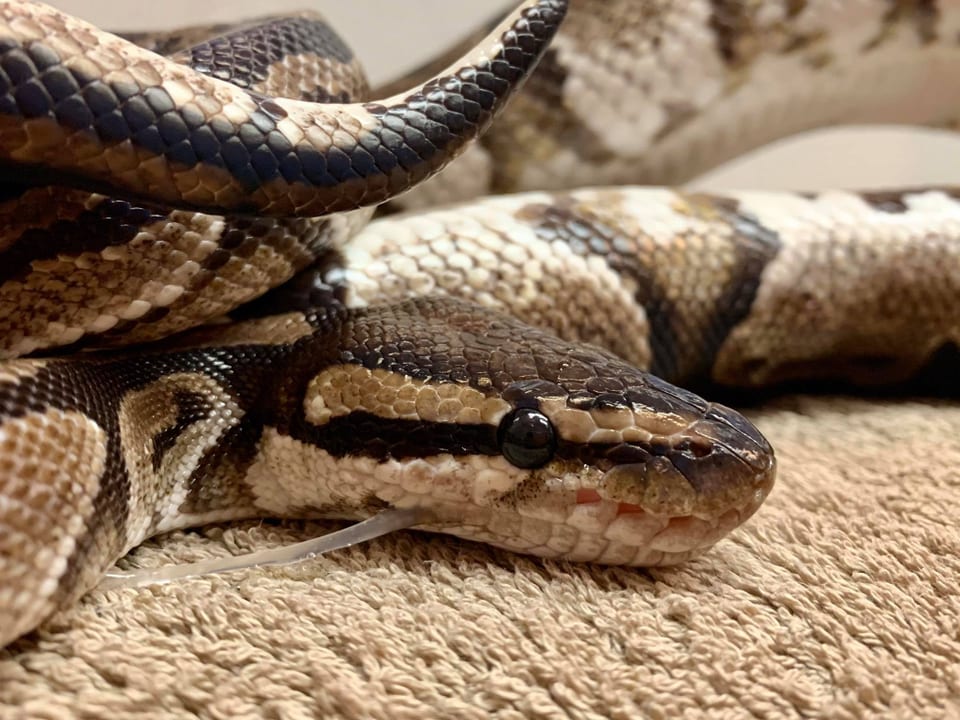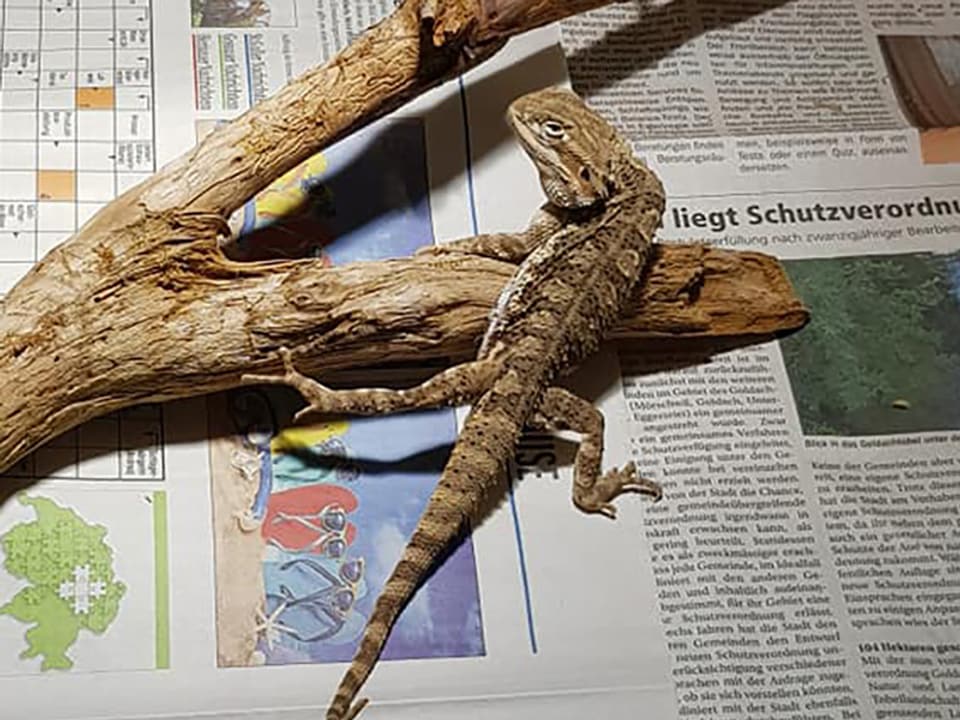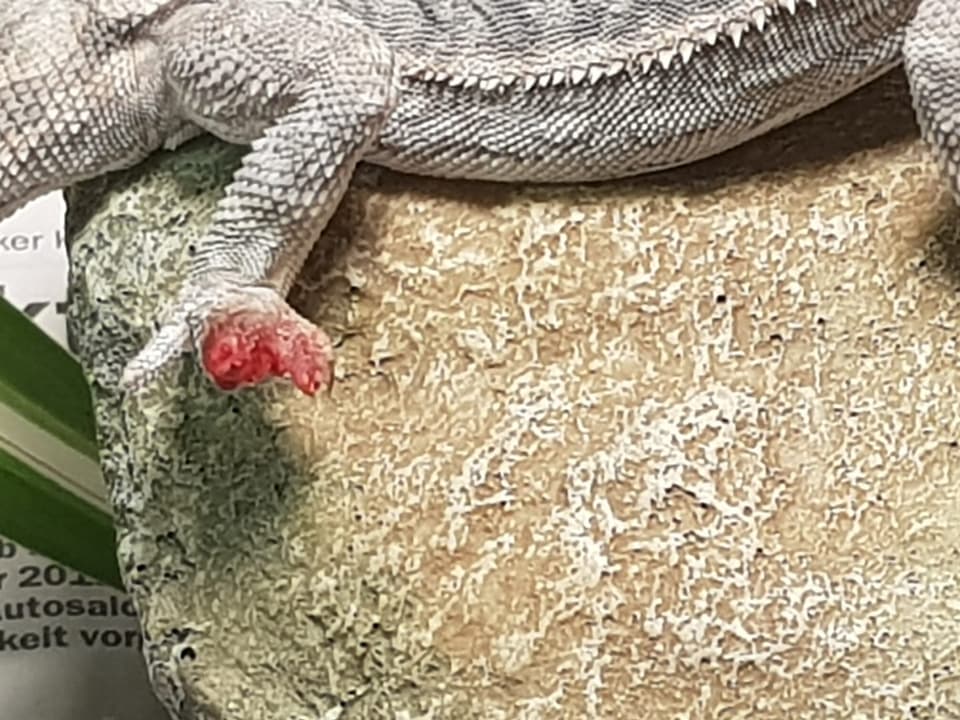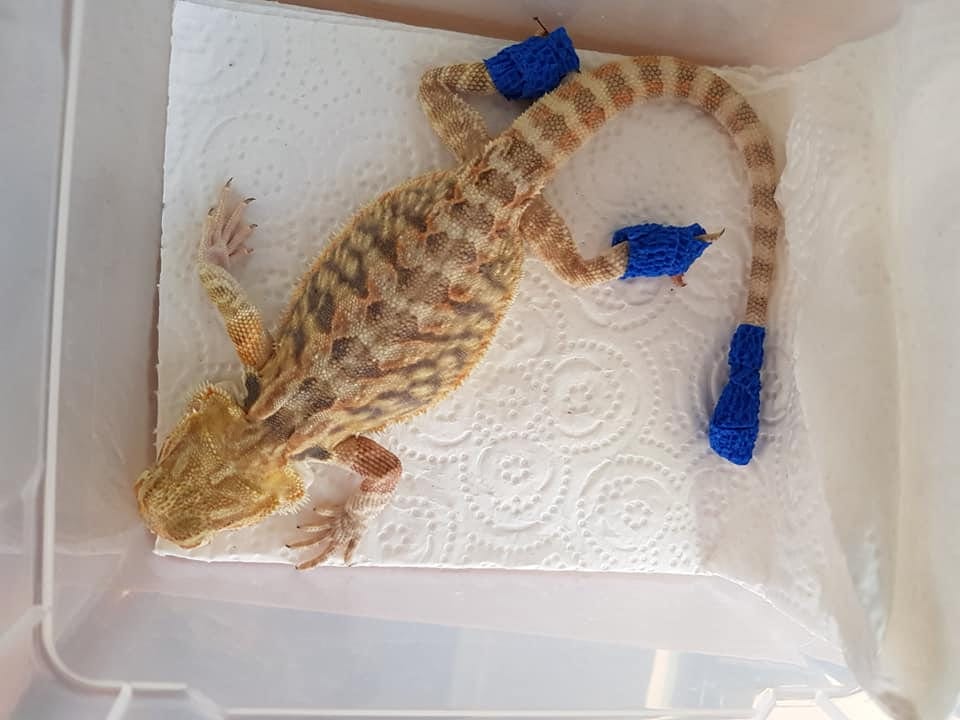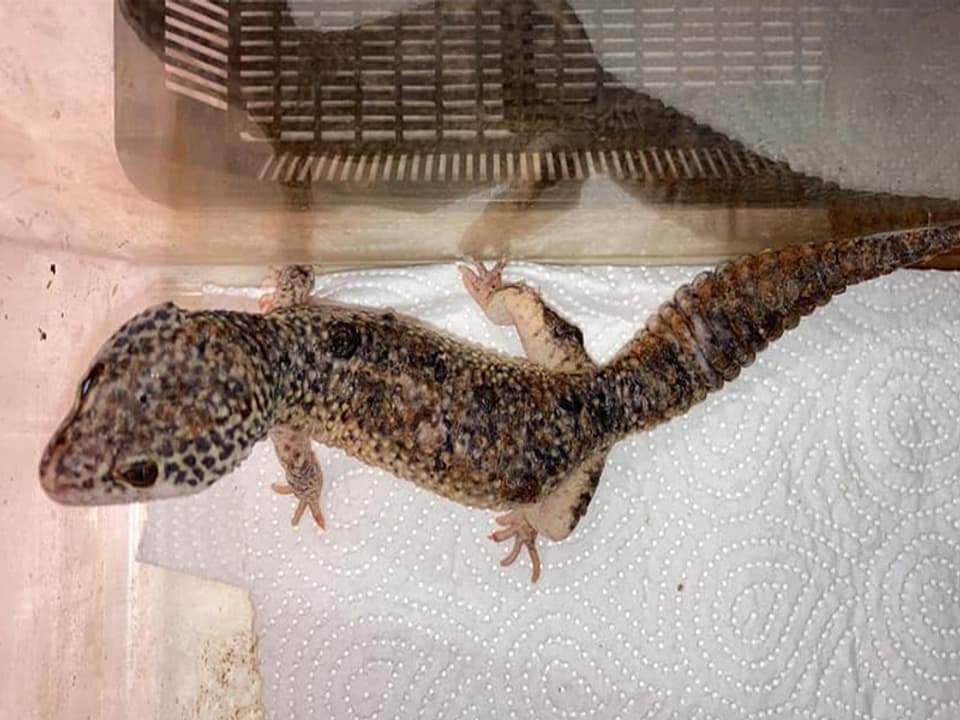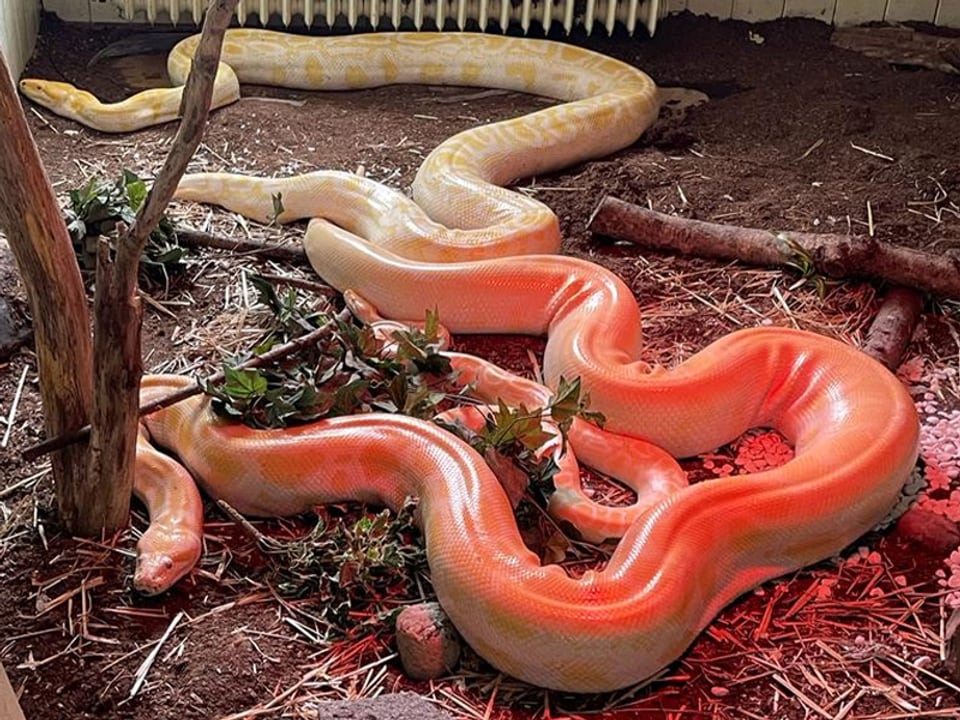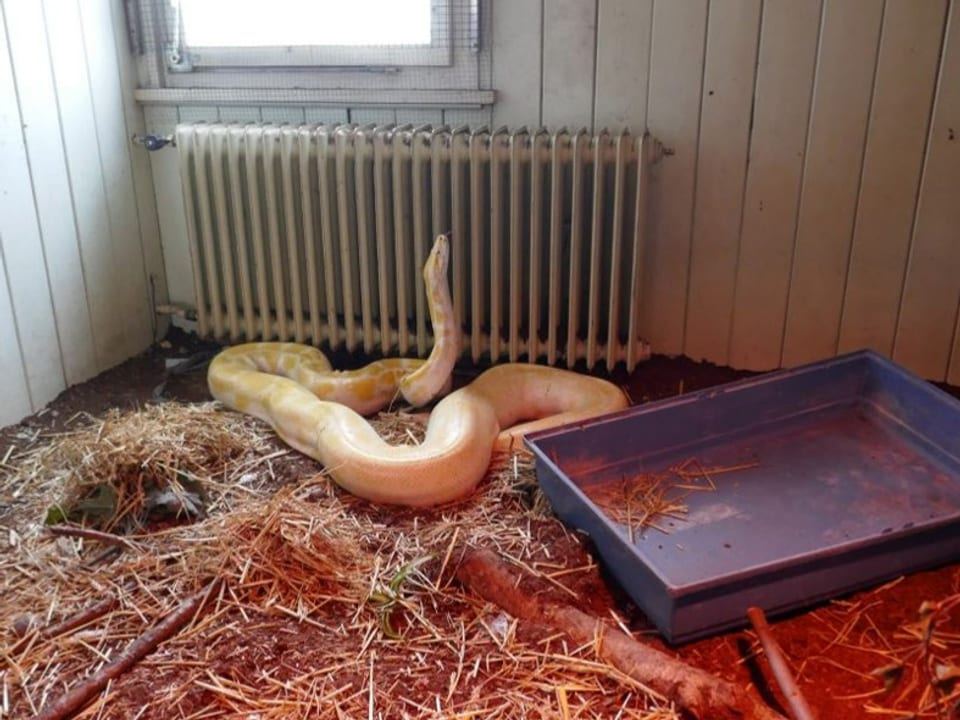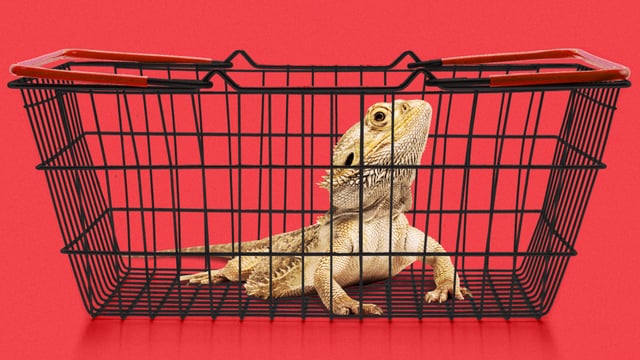“The problem is that reptiles live for a very long time. Hardly anyone is prepared to shoulder the responsibility for a longer period of time,” says Silvia Bruderer. She runs a sanctuary for reptiles in Heiden AR. There, Bruderer takes in lizards and snakes that the cantonal veterinary office takes away from their owners, for example when they are overwhelmed by the demanding animals.
Legend:
She takes care of neglected reptiles in her free time: Silvia Bruderer, founder of the “Reptile Sanctuary Association”.
SRF
She also buys neglected reptiles from online marketplaces – and there are a lot of these animals, she says. But space in their reception center is running out. Requests to take reptiles have increased over the last five years.
Silvia Bruderer criticizes: Reptiles are often purchased too carelessly and incorrect husbandry leads to serious injuries. She has already taken in leopard geckos with skin cancer because UV lamps that were too hot burned the skin. Or lizards with broken spines and severe bite injuries, which meant their legs and tails had to be amputated. As well as snakes with pneumonia.
“As soon as an animal no longer looks the way it should, owners often just want to get rid of it quickly,” says Bruderer. She cares for the injured animals on a voluntary basis and, if possible, places them with new owners. Your reception center is organized independently.
Half of the postures are not species-appropriate
The organization “Swiss Animal Protection” operates its own rescue centers. More and more reptiles are being placed in these alone. While there were around 850 reptiles across Switzerland in 2020, over 1,100 reptiles were given away in 2022. In Switzerland there are legal regulations regarding keeping reptiles. These are stipulated in the animal protection regulations. It states, for example, how big a terrarium must be and what regulations the keeper must adhere to regarding furnishings.
A survey by “Swiss Animal Protection” from 2020 shows: Almost half of reptile keeping is not species-appropriate – that is, there was evidence of at least one violation of Swiss animal protection legislation. The terrariums are often too small or errors have been made with the lighting, temperature or humidity in the terrarium.
Illegal animal husbandry exacerbates the problem
Additional regulations apply to large, dangerous or particularly sensitive reptiles. For example, with poisonous snakes, giant snakes over three meters long, large lizards or chameleons. Owners of these reptiles require a permit from the cantonal veterinary office. For this you have to complete a course.
These animals, which require a permit, are particularly demanding to keep and care for. The risk of them being kept incorrectly is correspondingly high. If such animals are kept illegally, there is no possibility of control.
Consequences for reptile owners
SRF Investigativ had access to several criminal orders against reptile owners in recent years. In a case from Basel-Stadt, an owner kept 28 snakes – most of them poisonous – without a permit to keep them. The fine was 7,500 francs.
In another case from eastern Switzerland, the veterinary office confiscated two large tiger pythons and reported the owner. The animals, more than 3.5 meters long, lived in poor conditions in a room in his apartment. There they sustained skin injuries, probably on the radiator. In addition, there was no permit to keep the giant snakes. These criminal proceedings are still ongoing and the presumption of innocence applies.
High number of unreported cases suspected
The “Tier im Recht” foundation collects such criminal orders in a database. The lawyer Bianca Körner observes a constant number of around 50 animal welfare cases per year involving reptiles. She says: “Compared to the number of reptiles kept, this number of cases is relatively small. We assume that there is a high number of unreported cases that are not being prosecuted.”

Legend:
Calls for consistent prosecution of animal protection criminal cases: Bianca Körner, lawyer at “Tier im Recht”.
SRF
The reason is that many reptiles are kept in secret and cannot really make themselves known when they are in pain. Bianca Körner sees the cantonal veterinary offices as having a duty: “It is important that the veterinary offices act consistently and file criminal charges if they discover a case of animal protection.”
Veterinary offices have a duty?
Are the relevant cantonal veterinary offices not carrying out enough checks? Regula Vogel from the Zurich Veterinary Office speaks on behalf of the Association of Swiss Cantonal Veterinarians. She is of the opinion that veterinary offices could not control any more. Because that would mean they would have to go door to door. “We certainly don’t have the resources for that,” says Regula Vogel.

Legend:
Doesn’t think additional controls are appropriate: Regula Vogel, cantonal veterinarian at the Zurich Veterinary Office.
SRF
In addition, the veterinary offices have discretion not to report every case, says Vogel. “We set the red line when it comes to animal cruelty or neglect.”
SRF has compiled the most common errors in four reptile species popular in Switzerland.
Leopard geckos are scaly reptiles that live primarily on the ground. They originally come from the dry regions of Central Asia and are among the most popular domestic reptiles. Leopard geckos can live over 40 years, grow up to 20 centimeters long and weigh between 50-60 grams. They are nocturnal lizards that like to hide during the day.
Most common posture mistakes
According to reptile experts, these are the most common husbandry mistakes:
- UV lamp too hot: This can lead to burns and even skin cancer.
- Loose sand instead of solid clay sand as terrarium soil: The sand is eaten, accumulates in the stomach and can lead to an intestinal obstruction.
- Males kept in the same terrarium: This leads to territorial fights. Corresponding bite injuries can be fatal for leopard geckos.
- Missing or too small wet box: This can lead to shedding problems such as dying toes.
You can find further information about keeping reptiles, for example on the “Swiss Animal Protection” website.
Bearded dragons are scale reptiles that like to climb high. They originally come from the dry deserts of Australia. Bearded dragons can live up to 20 years, grow up to 55 centimeters long and weigh up to 400 grams. They are diurnal lizards that are very agile and can sprint short distances.
Most common posture mistakes
According to reptile experts, these are the most common husbandry mistakes:
- Terrarium too dark: Because bearded dragons are diurnal, they need a very powerful UV metal halide lamp with a ballast in addition to natural daylight.
- Wrong food: Bearded dragons like insects and wild herbs such as dandelions. Common feeding with vegetables and fruits is not suitable as the fructose promotes parasite growth and can lead to diarrhea.
- Group keeping: Bearded dragons are solitary creatures and should not be kept in groups. Otherwise, bite injuries can occur, including severed limbs.
You can find further information about keeping reptiles, for example on the “Swiss Animal Protection” website
The ball python is a giant snake and originally comes from the savannahs of West and Central Africa. Ball pythons can live up to 40 years. They reach a length of around 150 centimeters and weigh up to five kilograms. These snakes are nocturnal solitary creatures and spend most of their lives in hiding.
Most common posture mistakes
According to reptile experts, these are the most common husbandry mistakes:
- Terrarium too low: Since ball pythons do not climb particularly often, they are often kept in terrariums that are too low. But they need the altitude to regulate their body temperature and get enough exercise.
- Night temperature too cool: Ball pythons need a night temperature of around 24 degrees, otherwise they can get pneumonia.
- Touch: Ball pythons should not be taken out of the terrarium as they are rather shy animals. Touching causes stress, which can lead to poor eating habits.
You can find further information about keeping reptiles, for example on the “Swiss Animal Protection” website
The boa constrictor is a giant snake and originally comes from the moist forests and savannahs of South and Central America. These snakes live up to 40 years, are up to three and a half meters long and weigh up to 25 kilograms. The boa constrictor is nocturnal and spends most of its life on the ground, although it can also climb well.
Most common posture mistakes
According to reptile experts, these are the most common husbandry mistakes:
- Terrarium too small: The terrarium is often purchased together with the small young animals, but they will soon grow in length and can quickly outgrow the terrarium.
- Pair position: It is recommended not to keep boas with mixed sexes, as they are viviparous reptiles that give birth to around 25 young per litter. This can quickly lead to space problems.
- Water bowl too small: If the boa constrictor’s body does not fit completely into the water bowl, shedding problems can occur.
You can find further information about keeping reptiles, for example on the “Swiss Animal Protection” website

